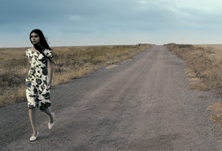
The feature film debut by visual artist Shirin Neshat is based on the eponymous novel by Iranian emigrant Shahrnush Parsipur. Parsipur was imprisoned and her book was banned because it included taboo themes dealing openly with female sexuality.
The film, an allegorical tale of four women and their journey to independence in Persia, is set in 1953; a cataclysmic moment in Iranian history when a CIA backed coup d'état brought down the democratically elected Prime Minister, Mohammad Mossadegh, and reinstalled the Shah to power. As the political turmoil swells in the streets of Tehran, the destinies of the women converge in a beautiful orchard, where they find independence, solace and companionship. |
|

Like the author, Shirin Neshat places herself in the tradition of magic realism, which combines a realistic narrative with the supernatural and phantastic. Neshat emphasises that the women leave their past behind to look for an idea of change and transformation, thereby transcending the Iranian context. The mesmerizing and strikingly beautiful imagery was developed out of five large-scale installations (some of which were shown at the Stedelijk Museum). The film, with music by Japanese composer Ryuichi Sakamoto, scooped up a Silver Lion award, the UNICEF award and a nomination for the Golden Lion at the Venice Film Festival.
Women without Men is distributed by EYE Film Institute Netherlands and will be the opening film of Doku.Arts. Shirin Neshat will attend the festival screening along with the film’s co-director Shoja Azari and art director Shahram Karimi. |
|
Zanan-e bedun-e mardan
Germany / Austria / France
2009
99 min. / 35 mm
Language: Persian
Subtitles: Dutch
www.womenwithoutmenfilm.com
Crew
Screenplay: Shirin Neshat and Shoja Azari
Cinematography: Martin Gschlacht
Sound: Uve Haussig
Editing: George Cragg, Jay Rabinowitz, Julia Wiedwald, Patrick Lambertz, Christof Schertenleib and Sam Neave
Production: Susanne Marian, Martin Gschlacht, Philippe Bober for Essential Filmproduktion, Coop99, Parisienne de Production
Distribution: CoProduction Office
Dutch Distribution: EYE Film Institute Netherlands
Director
Shirin Neshat left Iran in 1974 to study art at the University of California. The revolution meant that she was unable to return to Iran until 1990. Between 1993 and 1997 she produced a series of groundbreaking photographs called Women of Allah, superimposed farsi calligraphy on hands and faces. Around this time, Neshat began to turn her attention and her aesthetic sensibility to film. She has since received numerous of prizes and lives and has exhibited in many museums and galleries such as the Gladstone Gallery, Serpentine Gallery and Stedelijk Museum Amsterdam. |